Welcome to Clovis, New Mexico, an excellent destination for bird-watching! Clovis is home to various birds, from small migratory songbirds to large raptors.
Over 135 species of birds can be seen in Clovis, from the American Kestrel to the Great Horned Owl. The Clovis area is also a great place to watch for migrating waterfowl, such as ducks and geese, and shorebirds, like sandpipers and plovers.
Bird watchers come from all over the world to see the variety of avian species that inhabit Clovis. Whether you’re a novice bird watcher or a seasoned enthusiast, Clovis is an ideal destination for birding.
24 Birds to Watch in Clovis
Amidst the serene landscapes of Clovis, a city renowned for its natural beauty and diverse wildlife, lies a treasure trove for avid bird enthusiasts.
With its rich ecosystem encompassing lush parks, meandering trails, and tranquil water bodies, Clovis provides an ideal habitat for a plethora of avian species to thrive.
Whether you’re a seasoned birder or a casual observer, the avifauna of Clovis offers an enchanting spectacle, captivating hearts and minds alike.
Here are 24 Birds to Watch in Clovis.
1. Yellow-Rumped Warbler
The yellow-rumped warbler is a species of bird native to North America. It is a migratory bird that can be found throughout the continent, from the northernmost regions to the southernmost parts.
This warbler species is easily distinguished by its bright yellow rump patch, which is visible throughout the year. During the winter, many of these birds migrate to warmer climates, such as Mexico, the Caribbean, and Central America.
During the breeding season, they can be found virtually every corner of North America. The yellow-rumped warbler is a relatively small bird, measuring around 4.5 to 5.5 inches in length.
It has a variety of colors, but its back is usually grayish-olive, its underside is white, and its head is generally grayish-black. Its distinctive yellow rump patch can be seen easily, even from a distance.
This warbler species is omnivorous, meaning it eats both insects and fruits. It can often be seen at bird feeders, foraging for food. The yellow-rumped warbler is a regular North American bird species that can be commonly observed all across the continent.
Its bright yellow rump patch makes it easy to spot, and its wide range of habitats makes it easy to find. It is a great species to observe, as it is attractive and exciting.
| Kingdom | Animalia |
| Phylum | Chordata |
| Class | Aves |
| Order | Passeriformes |
| Family | Parulidae |
| Genus | Setophaga |
| Species | S. coronata |
2. Olive-Sided Flycatcher
The olive-sided flycatcher is a species of passerine bird belonging to the family Tyrannidae, also known as the Tyrant flycatcher family.
This small to medium-sized bird is a migratory species that travels from its wintering grounds in South America to its breeding grounds in North America during summer.
The olive-sided flycatcher is an agile and active flyer, often seen in pursuit of flying insects, its primary food source. Its wings are well adapted to dart and swoop through the air for prey quickly.
The olive-sided flycatcher is a relatively common bird, often found in open fields, forests, and shrublands. It is a vocal bird, typically making a loud “check” sound that can be heard over long distances.
| Kingdom | Animalia |
| Phylum | Chordata |
| Class | Aves |
| Order | Passeriformes |
| Family | Tyrannidae |
| Genus | Contopus |
| Species | C. cooperi |
3. White-Crowned Sparrow
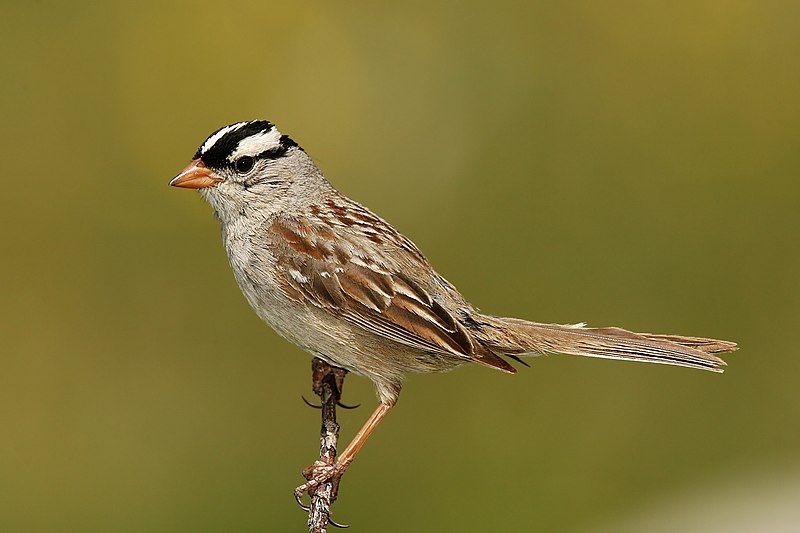
The white-crowned sparrow is a species of passerine ibis native to North America. It is a medium-sized New World sparrow family member, measuring 5 to 6 inches long.
This species is characterized by its grey face and unique black and white streaking on the upper head. The white-crowned sparrow’s streaking is its most notable feature and can be used to differentiate it from other birds of the same family.
The streaking on its head consists of two broad black stripes on the crown, with a white stripe in the center, giving it its name. The bird also has a white throat, grey cheeks, and white eyebrows. Its wings and tail are dark brown and its underparts are a light tan.
The white-crowned sparrow can be found in a variety of habitats, including coniferous forests, riparian thickets, meadows, and grasslands. They migrate in flocks and are usually seen perched on low branches or foraging on the ground.
They mainly feed on seeds, but also eat insects, fruits, and grains. The white-crowned sparrow is an integral part of North American bird life, and its unique markings make it a distinctive species.
Its diet and behavior make it an exciting bird to observe, as they are a common sight in many parts of the continent.
| Kingdom | Animalia |
| Phylum | Chordata |
| Class | Aves |
| Order | Passeriformes |
| Family | Passerellidae |
| Genus | Zonotrichia |
| Species | Z. leucophrys |
4. Scissor-Tailed Flycatcher
The scissor-tailed flycatcher is a beautiful bird that is found in North and Central America. It is a member of the Tyrannus genus, which is part of a larger group of birds known as kingbirds.
This bird is also known by two other names: Texas bird-of-paradise, and its long tail and colors easily recognize its long tail and colors. The scissor-tailed flycatcher is an insectivorous bird, which means that it primarily feeds on insects.
It has a wide range of habitats and can be found in both open woodlands and grasslands. These birds are most often seen in the early morning and late afternoon when they are actively foraging for food.
They have a very distinctive call, which is a loud, melodic trill. The scissor-tailed flycatcher is an integral part of the ecosystem in North and Central America.
These birds help keep insect populations in check and are also crucial as pollinators for specific plants. They are also a great source of beauty and a pleasure to watch.
| Kingdom | Animalia |
| Phylum | Chordata |
| Class | Aves |
| Order | Passeriformes |
| Family | Tyrannidae |
| Genus | Tyrannus |
| Species | T. forficatus |
5. Dark-Eyed Junco
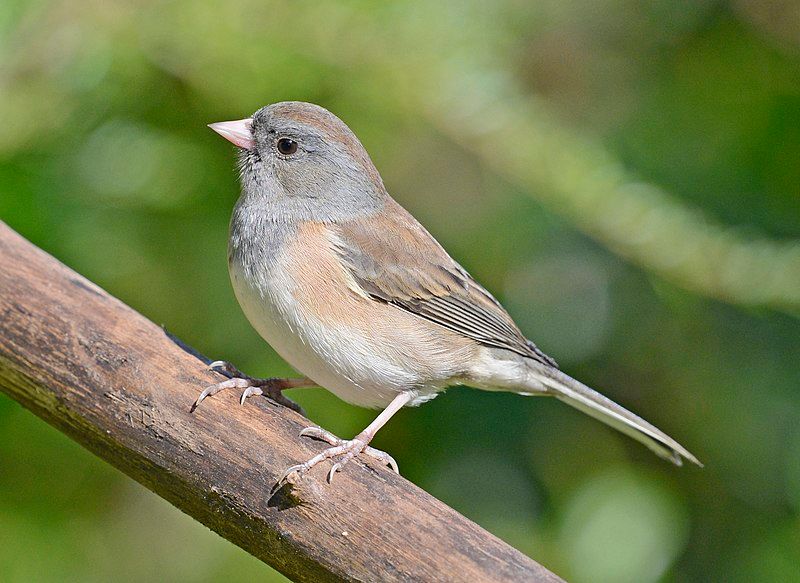
The dark-eyed junco is a species of small, grayish sparrow that is found throughout much of North America and in the Arctic during the summer months. It is a very diverse species, similar to the fox sparrow, and its classification is still not completely clear.
This bird is found in both temperate and cold climates and is quite common across its range. It has a unique black eye stripe that gives it its name, and its wings are grayish brown with white outer feathers. Its body is generally gray, and its underparts are white.
It lives in a variety of habitats, from woodlands and shrublands to open fields and wetlands. The dark-eyed junco is a social bird, often found in flocks, and it feeds on a variety of plant materials, such as grains, seeds, fruits, and insects.
It is a songbird, with a distinct, melodious song that is easily recognized. The dark-eyed junco is a hardy bird that is well adapted to the changing climates of its range, and it is a valuable part of North American ecosystems.
| Kingdom | Animalia |
| Phylum | Chordata |
| Class | Aves |
| Order | Passeriformes |
| Family | Passerellidae |
| Genus | Junco |
| Species | J. hyemalis |
6. Hammond’s Flycatcher
Hammond’s flycatcher is a species of bird belonging to the Tyrannidae family, commonly known as flycatchers. This small bird has an insectivorous diet and can be found in coniferous and mixed forest habitats of North America.
The species was named after William Alexander Hammond, the surgeon general of the United States Army. Hammond was a prominent figure in American history and is credited for his work in the field of medicine during the Civil War.
This bird is a reminder of his accomplishments and is a symbol of his legacy. It is a small but essential part of the avian population in western North America, and its presence helps to keep the local ecosystems healthy.
The Hammond’s flycatcher is an integral part of the natural balance in the region, and its conservation is essential for the species’ future.
| Kingdom | Animalia |
| Phylum | Chordata |
| Class | Aves |
| Order | Passeriformes |
| Family | Tyrannidae |
| Genus | Empidonax |
| Species | E. hammondii |
7. Long-Billed Curlew
The long-billed curlew is a large shorebird species that is mainly found in North America. It belongs to the family Scolopacidae, which also includes other species such as sandpipers and woodcocks.
This species is often referred to by many different names, including “sickle.” id,” and “candlestick bird.”
The long-billed curlew breeds mainly in central and western North America during the warmer months of the year, and then migrates southward and towards the coast in the wintertime in order to find a warmer climate and more food sources.
This species is well adapted to the colder temperatures and is able to survive during the winter months, but it is more common to find them migrating during the winter.
Overall, the long-billed curlew is a species that is very important to the North American shorebird population.
It is one of the few species of shorebird that is able to survive in colder climates and is able to migrate during the winter months in order to find more favorable conditions.
This species is also well-known for its unique appearance and has many different nicknames.
| Kingdom | Animalia |
| Phylum | Chordata |
| Class | Aves |
| Order | Charadriiformes |
| Family | Scolopacidae |
| Genus | Numenius |
| Species | N. americanus |
8. Ash-Throated Flycatcher
The ash-throated flycatcher is a type of bird that belongs to the family of tyrant flycatchers. It is a passerine bird, meaning that it is a member of the large group of birds known as perching birds or songbirds.
The tyrant flycatcher family consists of over 400 species of birds spread across the Americas, from the Arctic to Tierra del Fuego. The ash-throated flycatcher is a medium-sized bird, ranging in size from 5.5 to 7 inches in length.
It has olive-gray upperparts and a white to yellowish-white underside. Its head and throat are ash-gray and its wings and tail are dark brown.
The bird has a light-colored bill and yellowish-white legs. The ash-throated flycatcher’s diet consists mainly of insects, which it captures in mid-air. It also eats fruits and berries, especially when insects are not plentiful.
It is a solitary bird, nesting in low shrubs and trees and forming small flocks in winter.
In the United States, these birds migrate south in the fall, often traveling in large flocks. The ash-throated flycatcher is a common bird in the western United States and is found throughout much of Mexico.
It is a species of most minor concern by the International Union for Conservation of Nature (IUCN), meaning its population is stable and not threatened with extinction.
| Kingdom | Animalia |
| Phylum | Chordata |
| Class | Aves |
| Order | Passeriformes |
| Family | Tyrannidae |
| Genus | Myiarchus |
| Species | M. cinerascens |
9. Red-Tailed Hawk
The red-tailed hawk is a magnificent raptor found across North America. It inhabits a wide variety of habitats including grasslands, canyons, forests, and urban areas.
This species is widely distributed throughout much of the continent, breeding in Alaska and northern Canada and extending all the way to Panama and the West Indies. It is one of the most abundant and recognized members of the genus Buteo, which includes hawks and buzzards.
The red-tailed hawk is a medium-sized bird of prey that typically has reddish-brown plumage on its back and white or pale gray on its underside. The tail is usually reddish brown with a dark terminal band.
This species has long, broad wings and a short, slightly rounded tail, making it easy to spot in flight. Its call is a loud, shrill “kee-eeeeer,” often repeated several times in a row.
The red-tailed hawk is an opportunistic feeder and scavenger and will eat a wide variety of small mammals, reptiles, insects, and carrion. It often perches on high vantage points, such as telephone poles or tree branches, to survey the area for prey.
It has also been known to hunt cooperatively with other raptors, such as eagles, has, ks, and owls. The red-tailed hawk is a highly adaptable species and is able to thrive in a variety of habitats.
It is also well-known for its aerial displays, such as its steep dives and tight circles, which can be seen in any open landscape. This species is an integral part of the North American avifauna and a symbol of strength and courage.
| Kingdom | Animalia |
| Phylum | Chordata |
| Class | Aves |
| Order | Accipitriformes |
| Family | Accipitridae |
| Genus | Buteo |
| Species | B. jamaicensis |
10. Spotted Towhee
The spotted towhee is a large sparrow species native to the New World. Taxonomy, or the scientific classification of organisms, has been a point of debate for this bird in recent years.
Prior to 1995, the spotted towhee and its eastern counterpart were considered a single species, the rufous-sided towhee. This species was then divided and classified separately, with the spotted towhee being the.
An older, outdated name for the spotted towhee is the Oregon towhee. This name was used prior to the bird being classified under its current name and is no longer in use.
The spotted towhee is an essential bird species with its unique classification, and its taxonomy has been the subject of much debate in recent decades.
| Kingdom | Animalia |
| Phylum | Chordata |
| Class | Aves |
| Order | Passeriformes |
| Family | Passerellidae |
| Genus | Pipilo |
| Species | P. maculatus |
11. Western Bluebird
The western bluebird is a species of small thrush native to North America. It is a member of the genus Sialia and is found in the western and southwestern parts of the continent.
It is a medium-sized songbird, around 18 cm in length, with an olive-gray back and a pale blue chest and belly. Its wings are brown with white bars, and its head is pale blue with an orange-red throat.
The western bluebird is a cavity nester and is often found nesting in old woodpecker holes and nest boxes. Its diet consists mainly of insects, berries, and other small invertebrates. It is frequently perched on fence posts and tree branches, singing its cheerful song.
The western bluebird is an essential species for the conservation of biological diversity, as it contributes to the food chain and helps to control insect populations. It is also a symbol of hope, renewal, and the beauty of nature.
| Kingdom | Animalia |
| Phylum | Chordata |
| Class | Aves |
| Order | Passeriformes |
| Family | Turdidae |
| Genus | Sialia |
| Species | S. mexicana |
12. Red-Shouldered Hawk
The red-shouldered hawk is a medium-sized species of Buteo, a type of hawk. Its breeding range is wide, covering eastern North America, the coast of California, northern Mexico, and northeastern-central Mexico.
It is a permanent resident throughout most of its range, meaning it does not migrate annually, though it is known that some northern birds will migrate mostly to central Mexico. This species of hawk is usually seen perched in a tree along woodlands on open fields.
They feed mainly on small rodents and reptiles, such as tiny birds, ds, and amphibians. They are pretty adaptable and are able to thrive in different habitats including urban and suburban areas.
Red-shouldered hawks are protected under the Migratory Bird Treaty Act and are considered a species of most minor concern by the IUCN.
| Kingdom | Animalia |
| Phylum | Chordata |
| Class | Aves |
| Order | Accipitriformes |
| Family | Accipitridae |
| Genus | Buteo |
| Species | B. lineatus |
13. House Sparrow
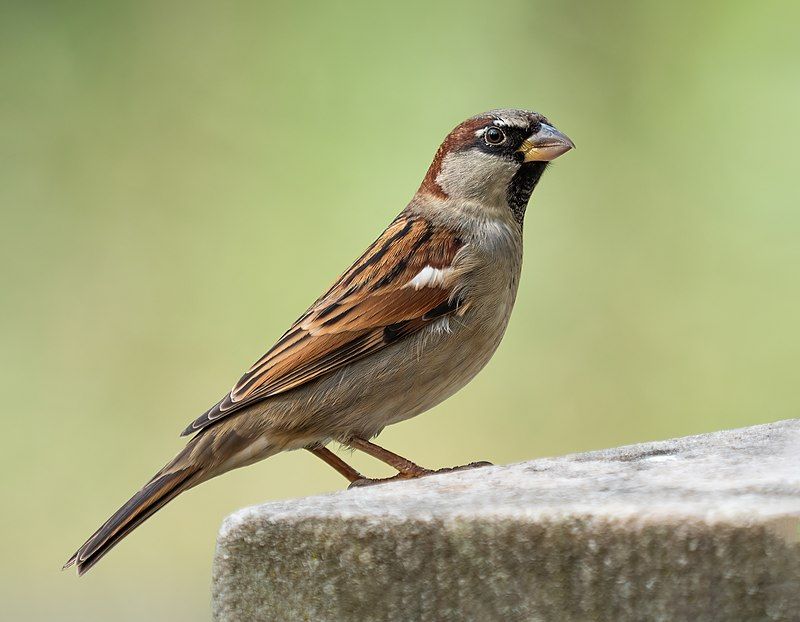
The house sparrow is a small bird that is part of the sparrow family Passeridae. It is found in most parts of the world, and has a typical length of 16 cm and a mass of 24–39.5 g.
The coloring of the house sparrow is dependant on gender; females and young birds are colored pale brown and grey, whereas males have more black, white, and brown markings.
These markings are used to attract a mate, and also help males to distinguish themselves from other male house sparrows. The coloring of the house sparrow can also help them blend in with their surroundings to protect them from predators.
The house sparrow is an adaptable species, which has enabled it to survive in many different types of habitats, from urban areas to rural landscapes.
| Kingdom | Animalia |
| Phylum | Chordata |
| Class | Aves |
| Order | Passeriformes |
| Family | Passeridae |
| Genus | Passer |
| Species | P. domesticus |
14. American Robin
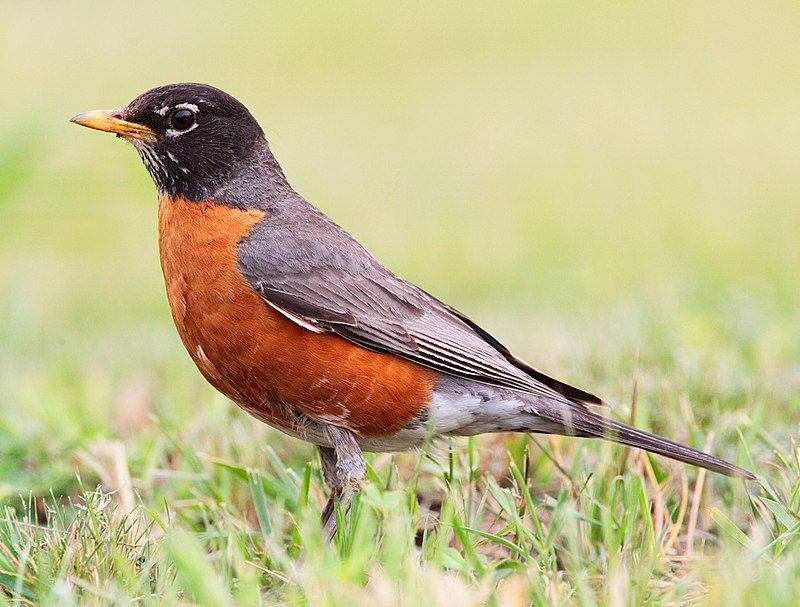
The American robin is a migratory bird found in the valid thrush genus and Turdidae family. It is named after the European robin due to its reddish-orange breast, however, the two species are not closely related. The European robin is a part of the Old World flycatcher family.
The American robin is widely distributed across North America and is common in gardens, parks, and forests. It has gray-brown upperparts and a paler belly. Its red breast is distinct, with a yellow beak and white-colored eyes.
The American robin is very adaptable and can survive in various habitats. It feeds mainly on worms, insects, and fruits. During the winter months, the American robin migrates south to warmer climates.
It is an important species as it helps disperse seeds, control insect populations, and provide a source of food for other animals.
| Kingdom | Animalia |
| Phylum | Chordata |
| Class | Aves |
| Order | Passeriformes |
| Family | Turdidae |
| Genus | Turdus |
| Species | T. migratorius |
15. American Wigeon
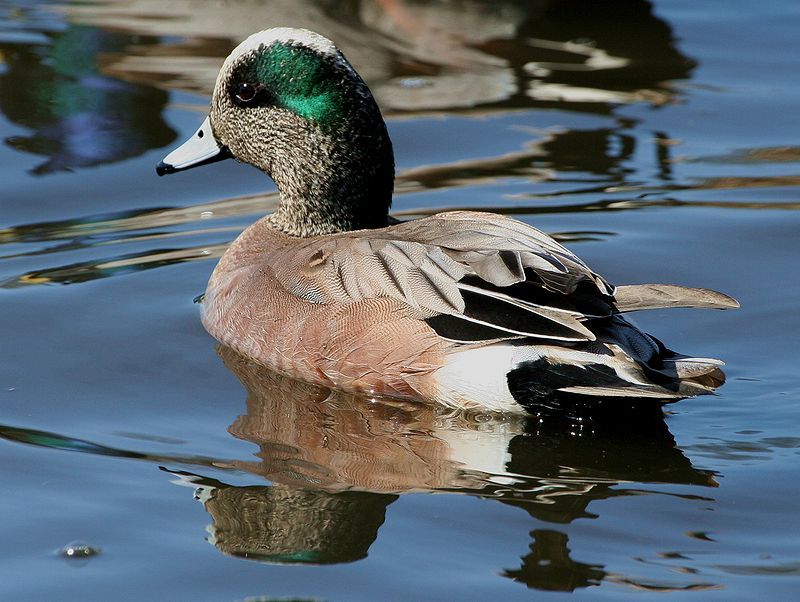
The American wigeon is a species of dabbling duck native to North America. It is sometimes called the baldpate due to its distinctive white head and neck plumage. It was previously classified in the Anas genus but is now placed in the dabbling duck genus Mareca.
The American wigeon is the New World counterpart of the Eurasian wigeon. It is slightly larger than the Eurasian wigeon and has a somewhat different plumage.
It has a brown head and neck, a white patch on the back of the head, a grayish-green back and wings, and a grayish-brown tail. The breast and belly are white, and the feet are yellow.
The American wigeon is found in open wetlands, lakes, and rivers and is an omnivorous feeder, eating plant and animal matter. It is a social species that often feeds and rests in large flocks.
| Kingdom | Animalia |
| Phylum | Chordata |
| Class | Aves |
| Order | Anseriformes |
| Family | Anatidae |
| Genus | Mareca |
| Species | M. americana |
16. White-Breasted Nuthatch
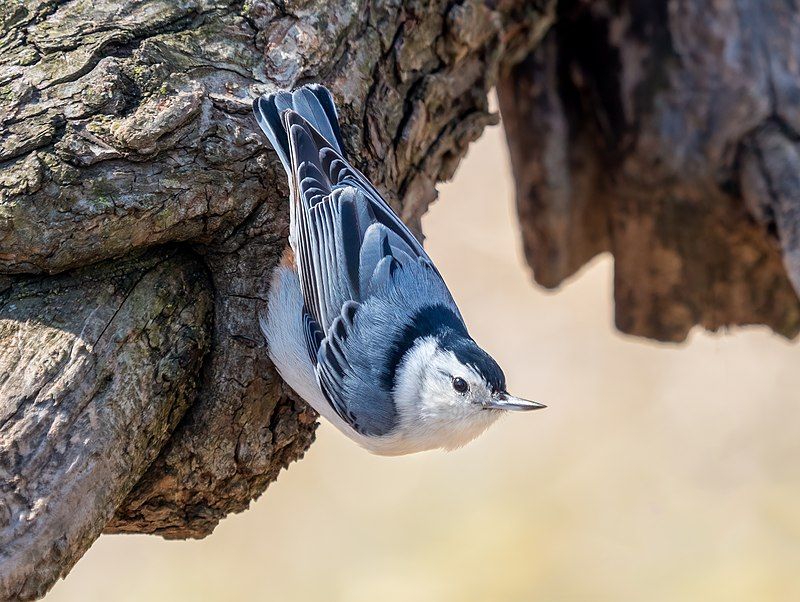
The white-breasted nuthatch is a species of bird in the family Sittidae. It is a small to medium-sized bird with an average length of 15.5 cm. The nuthatch is recognizable by its distinctive white breast and black head.
It has a grayish-brown back and wings, along with a white belly. Its tail is short and round, and its wings are long and pointed.
Its feet are strong and adapted for clinging to tree trunks and branches. The white-breasted nuthatch is a very vocal bird, making various noises that can be heard in many areas.
Its call is a loud, nasal “yank-yank” song, a series of high-pitched squeaks and trills.
It also makes various other calls, including a short “chip” and a low “hoot.”The white-breasted nuthatch is found in deciduous and coniferous forests throughout North America.
It is a year-round resident in some areas, while it migrates south in other regions in winter. It feeds mainly on insects, nuts, and seeds, which it finds by foraging on tree trunks and branches.
It will also eat berries and other fruits. The white-breasted nuthatch is a social biroftenbe seen in small groups. It will also form mixed-species flocks with other birds like chickadees, woodpeckers, and warblers.
It is a cavity nester and will use natural cavities in trees or nest boxes. The female lays four to seven eggs, and both parents feed and care for the young.
The white-breasted nuthatch is an essential species in North American forests, helping disperse seeds and controlling insect populations.
| Kingdom | Animalia |
| Phylum | Chordata |
| Class | Aves |
| Order | Passeriformes |
| Family | Sittidae |
| Genus | Sitta |
| Species | S. carolinensis |
17. American Woodcock
The American woodcock is a small bird species found in the eastern half of North America. It is also known by various colloquial names such as timberdoodle, bogsucker, hokum poke, translator, and Labrador twister.
This species is classified as a shorebird, a group of birds living near the shoreline of water bodies such as rivers and lakes. The American woodcock is mainly found in moist woodlands and meadows.
Its diet consists of insects and other invertebrates, which it locates by probing its long bill into the ground. Its range includes the eastern and central United States and parts of Canada, Mexico, and Cuba.
It is a migratory bird, which means it travels south during winter and returns to its breeding grounds in spring. The American woodcock is an important species to many ecosystems, as it provides food for various predators, including hawks and owls.
It is also a popular target for hunters in some of its range due to its exciting behavior and challenging nature. Despite its popularity, the American woodcock is listed as a species of most minor concern by the International Union for Conservation of Nature (IUCN).
This is due to its extensive range and stable population.
| Kingdom | Animalia |
| Phylum | Chordata |
| Class | Aves |
| Order | Charadriiformes |
| Family | Scolopacidae |
| Genus | Scolopax |
| Species | S. minor |
18. American White Pelican
The American white pelican is a large bird or Pelecaniformes, known for its aquatic and soaring habits. It breeds in the interior of North America, primarily in the springtime, before migrating south for the winter.
It can be found along the coasts of the United States and has been known to reach Costa Rica. The American white pelican is a powerful flier with a wingspan of up to 9 feet. It spends much of its time in the water, where it dives for fish and other aquatic prey.
During the nesting season, it builds its nest on the ground in colonies, often near ponds and lakes. The American white pelican is a distinctive bid, with a hefty bill, white and gray plumage, and a black patch on its shoulder.
It is a social bird often seen in large groups, swimming, soaring, and foraging together.
| Kingdom | Animalia |
| Phylum | Chordata |
| Class | Aves |
| Order | Pelecaniformes |
| Family | Pelecanidae |
| Genus | Pelecanus |
| Species | P. erythrorhynchos |
19. Black-Necked Stilt
The black-necked stilt is a species of shorebird found in and around the United States. It is most commonly found along the coastlines of California but is also found in the western interior of the country.
It is especially abundant in wetlands, where most of its food sources are found. The species has a long, thin black neck and long, thin red legs, giving it a distinct look.
The stilt is also easily identified by its white underbelly and black back. These birds are found in fresh and saltwater but prefer the brackish waters of estuaries and marshes.
They feed on various small aquatic invertebrates, such as mollusks, crustaceans, insects, and small fish. Thealsoto consume seeds, grains, and other plant material.
Black-necked stilts are highly social birds, often seen in large flocks and known to migrate long distances.
The black-necked stilt is listed as a species of most minor concern by the IUCN. However, it is considered a species of particular concern in some areas due to its localized population numbers. The Migratory Bird Treaty Act in the United States also protects it.
Despite this, the species is still vulnerable to habitat loss, pollution, and predation. Conservation efforts are necessary to ensure the long-term survival of the black-necked stilt.
| Kingdom | Animalia |
| Phylum | Chordata |
| Class | Aves |
| Order | Charadriiformes |
| Family | Recurvirostridae |
| Genus | Himantopus |
| Species | H. mexicanus |
20. Osprey
The Osprey is a large diurnal bird of prey. A few names know it, including sea hawk, river hawk, and fish hawk. Its range is widely spread across the world. This bird of prey is quite large, measuring over 60 cm in length and having wings that span 180 cm.
Its feathers are predominantly brown on the upperparts and greyish on the head and underparts. It mainly feeds on fish, hence its other name, fish hawk. The Osprey is a remarkable bird with its impressive size and talented fishing skills.
| Kingdom | Animalia |
| Phylum | Chordata |
| Class | Aves |
| Order | Accipitriformes |
| Family | Pandionidae |
| Genus | Pandion |
| Species | P. haliaetus |
21. Common Raven
The common raven is a type of bird that belongs to the passerine family. It is a large bird with an all-black plumage and can be found in various habitats across the Northern Hemisphere.
It is one of the most widely distributed corvid family species, including crows, magpies, and jays. The common raven is an adaptive species, able to survive in various environments. It is commonly found in forests, mountain ranges, grasslands, and deserts.
They are also known to inhabit cities, particularly in urban areas. Common ravens are highly intelligent and are known to use tools, cooperate, and form complex social relationships.
They are omnivores, feeding on various items such as insects, small mammals, carrion, and eggs. They are also known to scavenge for food and to feed on human garbage. Common ravens are vocal birds with an extensive repertoire of calls.
They are also known to mimic the calls of other birds and sounds from their environment. They are often seen in pairs or small groups, and during courtship, the male will perform elaborate aerial displays.
Overall, the common raven is an impressive species that has adapted to various habitats and is highly intelligent. It is an integral part of the ecosystem and signifies a healthy environment.
| Kingdom | Animalia |
| Phylum | Chordata |
| Class | Aves |
| Order | Passeriformes |
| Family | Corvidae |
| Genus | Corvus |
| Species | C. corax |
22. Loggerhead Shrike
The loggerhead shrike is a small songbird found in North America. It is a member of the Laniidae family, which is a family of birds that includes shrikes.
The loggerhead shrike is the only shark species native to North America, while other species are found in Siberia. The related northern shrike is found north of the range of the loggerhead shrike in Siberia.
The loggerhead shrike is known for its bold and aggressive behavior and its habit of impaling its prey on thorns or barbed wire. It is a carnivorous bird that feeds on insects, small mammals, and sometimes small birds.
The loggerhead shrike is considered a vulnerable species due to its declining population. Its habitats include grasslands, scrublands, and open woodlands, and it is most commonly found in the central and western United States.
Conservation efforts are being made to protect the species and its habitat.
| Kingdom | Animalia |
| Phylum | Chordata |
| Class | Aves |
| Order | Passeriformes |
| Family | Laniidae |
| Genus | Lanius |
| Species | L. ludovicianus |
23. Tree Swallow
The Tree Swallow is a migratory bird of the family Hirundinidae, which is found in the Americas. It was first described by French ornithologist Louis Vieillot in 1807 under the scientific name Hirundo bicolor.
Since then, the Tree Swallow has been transferred to a new genus, Tachycineta, and its phylogenetic placement within the genus is still being debated. The Tree Swallow is a small bird with a length of around 5-6 inches and a wingspan of 8-9 inches.
Its feathers are predominately blue-black, although males have brighter plumage than females. The Tree Swallow is an insectivore, feeding mainly on flying insects.
It nests in natural or artificial cavities and is an essential species for the conservation of insect populations. The Tree Swallow is a migratory species, spending the summer months in North America and the winter months in Central and South America.
Large flocks, seen in the sky from a distance, are known to form during the breeding season.
This species is also a vocal one, with a range of chirps and trills being used to communicate with other members of its flock. Overall, the Tree Swallow is an essential bird species in terms of its ecological role and as a source of enjoyment for birdwatchers.
Its scientific classification and phylogenetic placement are still being debated, but its beauty and importance in the natural world are not questioned.
| Kingdom | Animalia |
| Phylum | Chordata |
| Class | Aves |
| Order | Passeriformes |
| Family | Hirundinidae |
| Genus | Tachycineta |
| Species | T. bicolor |
24. Song Sparrow
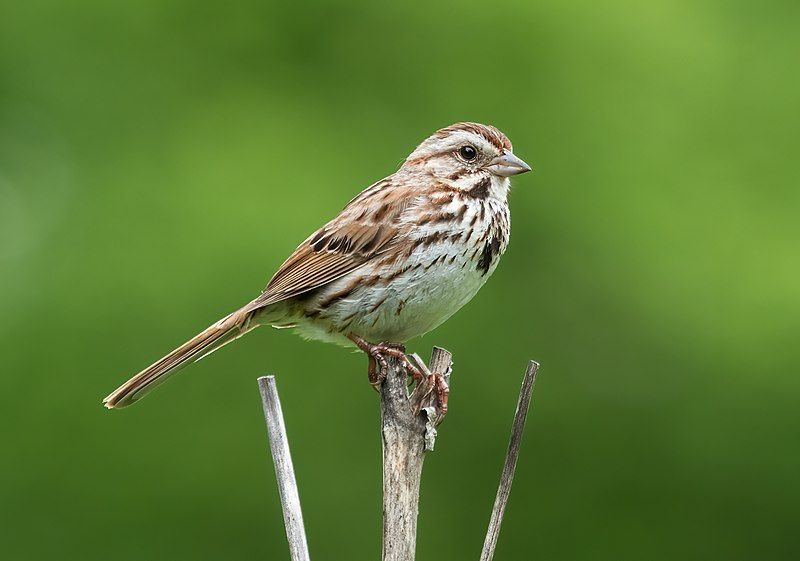
The song sparrow is a medium-sized passerine bird from the New World. It is one of the most abundant species of North American sparrows in various habitats across the continent.
It is a highly adaptable species, able to survive in a wide range of environments, from arid deserts to dense forests and wet meadows. Its variable plumage makes it hard to distinguish from other sparrow species, but its distinct song makes it recognizable.
It is also one of the most widespread sparrow species across North America. The species is well adapted to human-altered environments and is often found in urban parks and gardens.
They feed primarily on seeds and insects and are essential to the natural food chain.
| Kingdom | Animalia |
| Phylum | Chordata |
| Class | Aves |
| Order | Passeriformes |
| Family | Passerellidae |
| Genus | Melospiza |
| Species | M. melodia |
Conclusion
Birds are an essential part of the Clovis landscape. They provide beauty, color, and music to the area and are essential to the food chain.
Clovis residents can help to protect and conserve birds by providing bird feeders and birdhouses to provide food and shelter to the local birds.
By taking these simple steps, we can ensure that birds in Clovis remain healthy and abundant for generations.